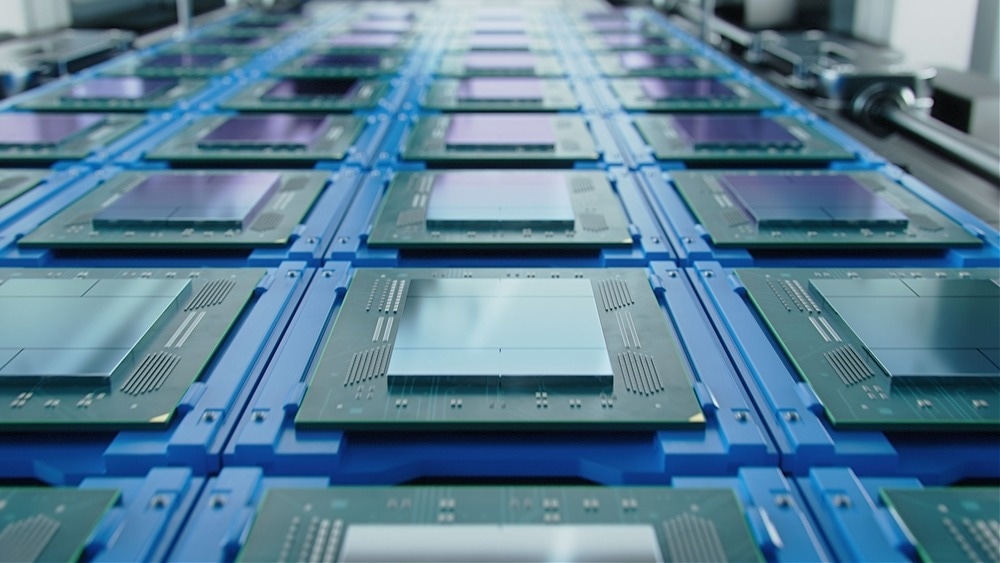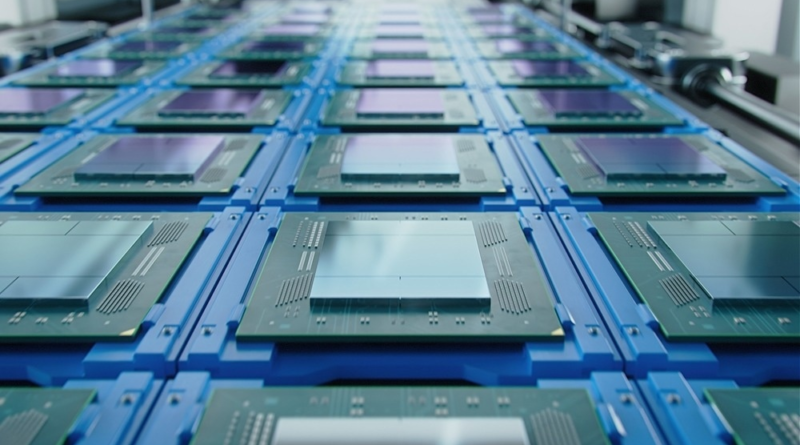Semiconductor Innovations for a More Efficient and Connected Future – AZoM
This article will discuss the function and construction of semiconductors and upcoming semiconductor innovations that are set to promote a more efficient and electronically connected future.
Image Credit: IM Imagery/Shutterstock.com
A semiconductor material is one that has a variable conductivity and resistivity value depending on temperature, besides other features such as crystal arrangement, which are specific to the material, but generally fall between that of conductive copper and insulating glass. A semiconductor electronic component, therefore, is constructed from one or more semiconducting materials such as silicon, germanium, or gallium arsenide, often modified chemically in a method known as “doping” in order to fine-tune the resistive properties of the semiconductor.
Semiconductors are typically constructed from silicon, as it is low cost compared to competitor materials and can be fairly easily fabricated into wafers. Metals such as germanium and several gallium crystals are also often used but are generally more difficult to fabricate into large wafers than silicon, though in some cases offer specific benefits that make their use viable.
For example, gallium nitride has a band gap three times larger than silicon and conducts electrons 1,000 times more efficiently, as well as possessing higher strength and thermal conductivity, making it useful in light-emitting diodes and radiofrequency components. Germanium was actually discovered earlier than silicon as a useful semiconducting material in 1886 but was quickly replaced owing to cost. In more recent decades, a plethora of more complex semiconductor materials have been investigated, leading to a number of semiconductor innovations.
The number of valence electrons available in a semiconductor material determines its conductivity; silicon has four, while gallium arsenide has eight, three from gallium, and five from arsenic. Tin oxide has 16 valence electrons and has increasingly been explored for applications in thin-film transistors owing to high carrier mobility, useful in flat panel displays and similar low-profile devices.
Speed is not the only consideration when it comes to semiconductors; one must also consider the frequency of the electrical signal which is similarly influenced by semiconductor material. For example, most communication is via radiowaves in the high MHz to GHz region, which silicon semiconductor components can interpret. As 5G is rolled out, capable of 100 GHz, silicon-only semiconductors may be unable to keep pace as high-power receivers and need to be replaced with mixed element semiconducting materials such as gallium nitride.
Nano-conductive components such as gold nanowires or graphene are increasingly incorporated with advanced semiconductor innovations in the generation of novel electronic devices. Graphene is a two-dimensional network of sp2 hybridized carbon atoms in a hexagonal structure, with a delocalized electron cloud connected by π-conjugation.
Graphene has high electrical conductivity and extremely fast electron mobility, large surface area, good optical transmittance, and is much stronger than steel in a mass-for-mass comparison while maintaining flexibility. Graphene itself is a zero-gap semiconductor, in that the conduction and valence band energies are touching, and thus there is no threshold energy requirement for promoting an electron, while the resistivity of the material is influenced by conditions such as temperature, flex, number of graphene layers, pressure, the presence of magnetic fields, or by traditional doping.
The use of bilayer graphene allows changes in band structure to be induced by the electric field effect between the two layers, which has allowed graphene to see use in flexible sensors and similar technologies. Traditional semiconductors can also be incorporated with graphene-based electronics to produce novel semiconductor innovations, taking advantage of the unique properties of graphene in conventional electronics.
Graphene may be set to replace silicon as the go-to material for semiconductors, as the iterant improvements made to silicon semiconductors over the last 50 years, which roughly followed Moore’s law, wherein the number of transistors on a circuit board doubles every two years (the year number has varied), appear to have slowed significantly.
The power of newly designed computer processors has plateaued since around 2010 compared to previous decades, and squeezing additional performance from silicon-based semiconductors is becoming increasingly costly with regard to research and development. Part of the reason for this limitation is the extremely close packing of transistors, to such an extent that quantum effects such as tunneling can occur, wherein an electron is able to pass the potential energy barrier and jump to an adjacent transistor.
This and other quantum phenomena are exploited in quantum computing, drastically improving computation speed over traditional processors by allowing superpositioning to occur, i.e., in binary coding, qubits can be 0 and 1 simultaneously. Graphene is of great interest as a semiconductor material in quantum computing, partially owing to its potentially multi-layered structure if engineered with gating structures connecting the layers. For example, quantum dots are semiconductor nanocrystals, often constructed from materials such as cadmium and selenium, germanium, gold, and even carbon, which can be placed between graphene layers as an electron transfer agent.
Future semiconductors are likely to be constructed from new and innovative materials such as graphene and advanced metal-ceramics where applications demand more power and higher frequencies than silicon is able to handle. The broad availability of silicon will ensure that it is to be used at least for decades to come, however, and semiconductor innovations surrounding silica alloys continue to be produced in spite of a slowing pace of improvements, even with useful applications in quantum computing.
What is the Role of the Depletion Region in a Semiconductor PN Junction?
Jing, F., Zhang, Z., Qin, G., Luo, G., Cao, G., Li, H., Song, X., & Guo, G. (2022). Gate‐Controlled Quantum Dots Based on 2D Materials. Advanced Quantum Technologies, 5(6), 2100162. https://doi.org/10.1002/qute.202100162
Obeng, Y. & Srinivasan, P. (2011). Graphene: Is It the Future for Semiconductors? An Overview of the Material, Devices, and Applications. The Electrochemical Society. https://www.electrochem.org/dl/interface/spr/spr11/spr11_p047-052.pdf
International roadmap for devices and systems. Semiconductor Materials. https://irds.ieee.org/topics/semiconductor-materials
Disclaimer: The views expressed here are those of the author expressed in their private capacity and do not necessarily represent the views of AZoM.com Limited T/A AZoNetwork the owner and operator of this website. This disclaimer forms part of the Terms and conditions of use of this website.
Written by
Michael graduated from the University of Salford with a Ph.D. in Biochemistry in 2023, and has keen research interests towards nanotechnology and its application to biological systems. Michael has written on a wide range of science communication and news topics within the life sciences and related fields since 2019, and engages extensively with current developments in journal publications.
Please use one of the following formats to cite this article in your essay, paper or report:
APA
Greenwood, Michael. (2023, October 31). Semiconductor Innovations for a More Efficient and Connected Future. AZoM. Retrieved on July 09, 2024 from https://www.azom.com/article.aspx?ArticleID=23133.
MLA
Greenwood, Michael. "Semiconductor Innovations for a More Efficient and Connected Future". AZoM. 09 July 2024. <https://www.azom.com/article.aspx?ArticleID=23133>.
Chicago
Greenwood, Michael. "Semiconductor Innovations for a More Efficient and Connected Future". AZoM. https://www.azom.com/article.aspx?ArticleID=23133. (accessed July 09, 2024).
Harvard
Greenwood, Michael. 2023. Semiconductor Innovations for a More Efficient and Connected Future. AZoM, viewed 09 July 2024, https://www.azom.com/article.aspx?ArticleID=23133.
Do you have a review, update or anything you would like to add to this article?
Cancel reply to comment
Daniel Goran
In our latest interview, AZoM speaks with Daniel Goran, Senior Product Manager for EBSD at Bruker, about making fully integrated EDS and EBSD affordable and easy to use by combining COXEM’s new EM-40 Tabletop SEM with Bruker’s QUANTAX ED-XS system.
Jonathan Sweedler
In this interview conducted at Pittcon 2024 in San Diego, we spoke to Professor Jonathan Sweedler about moving through your career as an analytical chemistry faculty.
Professor Arian van Asten
In this interview conducted at Pittcon 2024 in San Diego, we spoke to Professor Arian Van Asten about advancements in the chemical analysis of drugs and explosives using portable NIR spectroscopy and its significant impact on improving on-scene investigation methods for law enforcement agencies.
Discover how the Pyris™ TGA 9, DSC 9, and STA 9 systems are contributing to the future of thermal analysis.
This product profile highlights the optoCONTROL 2700, a high-performance LED micrometer from Micro-Epsilon, designed for precise 2D/3D measurements of diameter, gap, edge, and segment.
Discover Hiden Analytical's TDSLab Series – a range of cutting-edge tools for thermal desorption studies.
The global semiconductor market has entered an exciting period. Demand for chip technology is both driving the industry as well as hindering it, with current chip shortages predicted to last for some time. Current trends will likely shape the future of the industry, which is set to continue to show
The primary distinction between graphene-based batteries and solid-state batteries lies in the composition of either electrode. Although the cathode is commonly changed, carbon allotropes can also be employed in fabricating anodes.
In recent years, the IoT is rapidly being introduced into almost all sectors, but it has particular importance in the EV industry.
Your AI Powered Scientific Assistant
Hi, I’m Azthena, you can trust me to find commercial scientific answers from AZoNetwork.com.
A few things you need to know before we start. Please read and accept to continue.
Great. Ask your question.
Azthena may occasionally provide inaccurate responses.
Read the full terms.
Terms
While we only use edited and approved content for Azthena answers, it may on occasions provide incorrect responses. Please confirm any data provided with the related suppliers or authors. We do not provide medical advice, if you search for medical information you must always consult a medical professional before acting on any information provided.
Your questions, but not your email details will be shared with OpenAI and retained for 30 days in accordance with their privacy principles.
Please do not ask questions that use sensitive or confidential information.
Read the full Terms & Conditions.
Provide Feedback
AZoM.com – An AZoNetwork Site
Owned and operated by AZoNetwork, © 2000-2024

